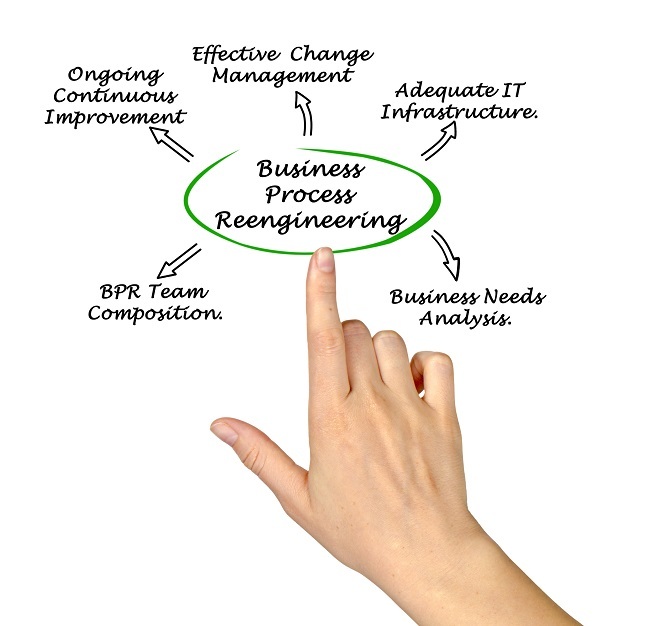
 Data Structure
Data Structure Networking
Networking RDBMS
RDBMS Operating System
Operating System Java
Java MS Excel
MS Excel iOS
iOS HTML
HTML CSS
CSS Android
Android Python
Python C Programming
C Programming C++
C++ C#
C# MongoDB
MongoDB MySQL
MySQL Javascript
Javascript PHP
PHP
- Selected Reading
- UPSC IAS Exams Notes
- Developer's Best Practices
- Questions and Answers
- Effective Resume Writing
- HR Interview Questions
- Computer Glossary
- Who is Who
Key Factors for a Successful Business Process Reengineering
Introduction
Business Process Reengineering as defined by Michael Hammer focuses on making a radical change on the process system as a whole to facilitate dramatic business outcomes. The traditional concept of automation or merely upgrading processes particularly with bulk investments in mechanization was not competent enough to deliver expected results. Incorporating technology without changing the existing structure and process of operations resulted only in speeding up operations. It failed to make an impact on business goals.
A substantial boost in revenue can be reaped only by identifying and addressing the fundamental defects of process and underlying systems of the entire operations. This is the essence of reengineering. In simple words it is breaking the existing, identifying the issues, analysing, planning, redesigning with business objectives and finally implementing it. The key factors that are detrimental to the success of this process of business process reengineering are discussed further.

Factors that Trigger BPR Success
Effective implementation of BPR ought to bring considerable success to the business. As in any other activity, reengineering too involves some amount of risk. However, organizations initiate reengineering process to implement change and boost efficiency as evidences prove successful BPR for high yielding outcomes. Hence, it is important to know about the key factors that are to be considered during reengineering efforts to make it successful.
Cross-Functional Commitment
Reengineering is not limited to a particular area or department. It is the thorough overhaul of a business entity. Inter and intra departmental, along with external parties including suppliers and customers form part of the BPR initiative.
Committed participation from all departments for gaining inputs prior to the reengineering efforts will enhance cooperation and acceptance of all parties involved. It could start from executive management for sufficient budget allocation, employee participation across units to collect insights and inputs on processes and customer preferences. There should be a unanimous organizational commitment and cooperation towards the goals to be attained. A strong leadership to recognise the necessity of change, a thorough understanding of BPR, strong, viable and creative capacity in deriving a clear business vision is essential for a successful BPR effort. All parties inked to the organization should be convinced and informed about the process.
Competent BPR Team
After ensuring the active involvement of all units, another factor that needs ample care is the formation of BPR Team. This team is pivotal for the effective operation and execution of reengineering activities. They are responsible for making strategic decisions, framing and proposing suggestions and timely communicating the BPR efforts to the entire business. BPR team the apex of the reengineering task should include competent and credible team mates, who motivate, organise, empower and train the peers with process mapping and brainstorming techniques. People associated with the BPR team should have notable leadership qualities with accountability and clarity of work, approach and final goals. Ideally, the team should have a representation from all major functional units and specifically from departments that are subject to change during the process of BPR.
Problem Identification
One of the main reasons for a BPR initiative to fail is the lack of proper isolation and identification of the problem and need for reengineering. The entire business process should undergo a thorough assessment and the exact areas or processes that require reengineering has to be recognised.
The need and strategy for reengineering should be clearly ascertained after conducting a series of sessions with the management and stake holders ensuring an in-depth analysis. Such activities will aid in developing a harmony uniting the vision and business processes. This will lead to logical decisions and plan activities that need to be discarded and those that need improvement. This is an essential ingredient to formulate an efficient basic design for BPR. Proper identification gives a clear understanding on the existing strength, weakness, market trends, and innovative advancements of competitors.
IT Infrastructure
Radically redesigning the processes and boosting market penetration will undoubtedly need innovation and used of advanced technology. Information technology is an inevitable part of business reengineering. Adequate and effective alignment of IT with BPR activity is crucial for the success of reengineering. This helps to develop proper infrastructure budget decision, quantify effectiveness of IT investment, integration and improving functional competency of information systems and appropriate use of IT tools that contribute to the success of reengineering activities. Thus it can be observed that IT infrastructure and process reengineering are interdependent. Recent studies have also reconfirmed that IT have a vital role in boosting reengineering efforts of an organisation.
Productive Change Management
BPR is all about initiating change. It triggers changes in people, work culture, process and technology. Conveying the need and necessity to initiate change is the first and foremost step of a successful BPR effort. Only a change in the mind set of people can facilitate a change in organisation.
There may arise many barriers of resistance that hinder the effective implementation of BPR. Managing change is considered a fundamental requirement for competing in a highly dynamic modern market. Resistance to change from units that are predicted to get maximum benefits from the reengineering process are often overlooked. The impact of cultural and structural changes is not given ample importance. This can result in BPR activity failing to achieve the projected benefits. The concept of change as a management technique should be made transparent to the people involved. Successful change management mechanisms can lessen the tension of transition.
Ensuring Sustainable Improvement
BPR is an ongoing activity as part of business improvement approach that helps an organization to drastically upgrade operational goals. Continuous refinement is required to optimize process, quality and delivery time to its maximum potential. The change cycle should be continually monitored and enhanced based on the information gathered from performance measurement tools. Constructive feedback mechanisms to capture customer opinions, escalations and resolutions will aid as inputs for further betterment of the system. This helps to cater to assessing and evaluating risk at the preliminary stage itself and making necessary corrections.
Risk management also assist in finding, assessing, responding and controlling uncertain events that contribute to the success of BPR. Thus to guarantee projected benefits from the reengineering process constant rectification and reformation activities are inevitable.
Conclusion
Summarizing the above facts, it can be seen that such prominent factors should be taken care for the success of BPR. Any business entity planning for a reengineering process should stay committed, reconfirm design and offer a comprehensive change, exercise change management techniques, efficiently implement it and follow up continuous improvement activities. Human resources involved are vital in the success of any revamping activity. They should be dedicated and coherently work towards the organizational objectives. Competency and commitment will enable employees to apply their knowledge and experience to give accurate suggestions and recommendations where ever necessary. Support of IT infrastructure for implementation and governance of new process and structure is also commendable. All these factors put together, will certainly lead the implementation of business process reengineering towards success.

